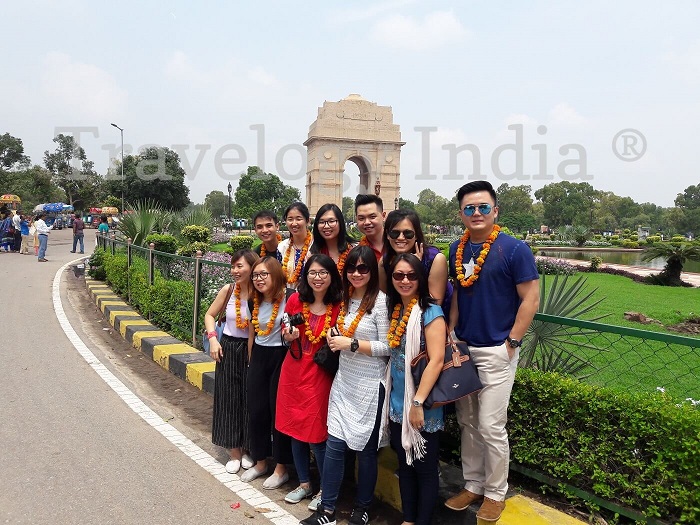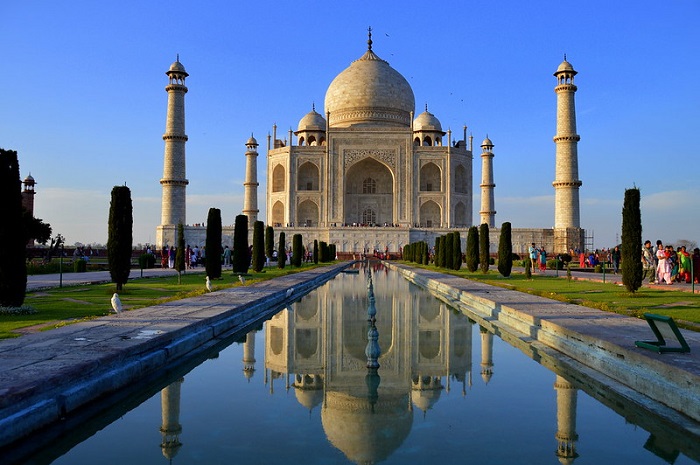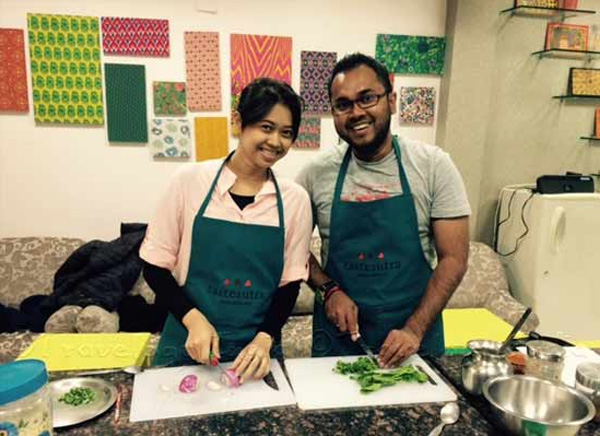Hazrat Nizamuddin Aulia Dargah Delhi
Delhi is an emotion. Also more than a city, every part of the city look like a celebration. People are always laughing and not taking life too seriously here. It is the heart of the country that beats in every individual. You can come from any background, follow any religion and have any and many interests; this city will never disappoint you. From being architecturally rich in its history, to modern metros and rails, from health cafes to soulful food paradises, Delhi is a well symphonized orchestra.
Delhi has a strong Mughal and Islamic memoire. Shah Jahan shifted the Mughal Empire capital from Agra to Delhi (then Shahjahanabad now Old Delhi), and it remained so until they were defeated by British Raj. It was once filled with mansions and nobles of the royal court, along with elegant mosques and gardens. Today, despite being extremely crowded, Delhi has maintained its old charm with old few monuments and havelis left, but still conserved. One such monument is the Hazrat Nizamuddin Dargah.
History
Situated to the west area of Delhi, the dargah is of one of the Sufi saints Khwaja Nizamuddin Auliya. The Sufi saint of the Chisti Order, was born in 1238 in Badayun, Uttar Pradesh. He traveled to Delhi to preach the Chisti Order and taught people that love and peace can help them get closer to God. His beliefs were to serve people irrespective to their caste, creed and religion. His vision of the world was marked by highly evolved sense of religious pluralism and kindness. It is believed his influence on the Muslims of Delhi caused a paradigm shift in their outlook of the world. Since the age of twenty, Nizamuddin went on become a disciple of Sufi saint Fariduddin Ganjshankar, also known as Baba Farid, who later named him is successor. He lived at various places in Delhi, before finally settling in Ghiyaspur, to remain undisturbed for the noise and hustle of the city. During his life, he had many disciples like Hazrat Nasiruddin Mahmud Chiragh Dehlavi and Amir Khusro, who achieved spiritual heights and were noted scholar/musician and royal poet to Delhi Sultanate.

The Sufi saint died on 3rd April 1325 and his shrine was constructed by Muhammad Bin Tughlaq of the Tughlaq dynasty, who was his avid follower. The shrine is visited by people of all faiths, around the year, with special congregations on death anniversaries of Nizamuddin Auliya and Amir Khusro, who is also buried at the Nizamuddin Dargah. Mughal princess Jehan Ara Begum and Inayat Khan, also have their tombs in the dargah complex.
Interior
Hazrat Nizamuddin Dargah is one of the most serene and peaceful places in Delhi. Built in the 14th century, it has undergone many renovations and restorations since then. The present structure dates back to 1562 and was renovated by Faridu’n Khan. The Islamic style of architecture dons jaalies, marbles arches and a courtyard. Built in a square shaped chamber engirdled by courtyards; most of which are covered by arched openings. The dome shaped dargah roof is adorned with vertical stripes, adding grandeur to the shrine. Women are not allowed to go beyond the other verandah, but they can view through the beautiful jaallis and lattice screens that embrace the marble arches and courtyards. The complex also has an old room called the Hujra-e-Qadeem, which dates back to 13th century with a calligraphed poem to remember the Sufi saint, which was inscribed by an Urdu poet Allama Iqbal. It is a local belief, to tie thread on the jaallis and lattice screens as a constant reminder to the saint of their wishes.

In addition to the main dargah complex, there is the Jama’t Khana Mosque on the west of the courtyard, with a high wall made of sandstone. There is also a miraculous stepwell. It is believed that the well was being built in secrecy, during Tughuqabad was in the making process, but the activities were later banned. The decedents of Nizamuddin Auliya later built the well using water lit lamps. The Chaunsath Khamba (64-pillars) is a beautiful Mughal-era monument, were one can find the grave of Mirza Ghalib, an Urdu and Persian language poet. Besides the dargah also serves the resting place of many eminent historical figures like Mughal princess Jehan Ara Begum, Shah Jahan’s daughter, who was an avid follower of the Sufi saint; a nobleman Atgah Khan and Muhammad Shah Rangila; alongwith Lal-Mahal, Chini Ka Burj, Kalan-Masjid and many more.
The dargah keeps alive the culture of Sufi spirituality, through devotees singing poetry and qawwali in honour of celebrating the Persian poet Amir Khusro, in the inlaid marble pavilion. Many Bollywood movies like Rockstar and Bajrangi Bhaijaan have been shot inside the dargah. Moreover, many different qawwalis have been composed and featured in various movies like Delhi 6 (Arziyan), Rockstar (Kun Faya Kun) and Ahista Ahista (Aawan Akhiyan Jawan Akhiyan); that are dedicated to Nizamuddin Auliya.
How to Reach
Situated in Delhi, the popular tourist destination is very well connected. People can reach via, air, rail and road from various different parts of the country or world. The dargah is a very popular pilgrim place and receives foreigners from across the globe.
Depending to where you are situated, one can choose to reach Delhi, i.e via air, rail or road. There are regular buses travelling to Delhi from major cities in the country. One can choose from A.C sleeper/Volvo buses to regular interstate/intercity buses, depending on the budget, time travelled and destination. Similarly, Delhi is well connected by rail from all states of India. Travel by train can be selected as per convenience. Nizamuddin station happens to be the closes to the dargah but not all trains stop at the station.

Delhi Travel Guide:
From all the major bus terminals and railway stations of Delhi, an auto, taxi or bus to the dargah will be easily available.
Delhi being the capital of India and a major city, has one of the largest international airport, Indira Gandhi International Airport, with flights from major countries. Moreover, it is also connected by key cities in India. From the airport, one can take an auto or cab and reach the dargah. Delhi is also has a good metro connectivity. If commuting via metro, Indraprastha (Blue line) and Jangpura (Violet line) are the closet metro stations. One can walk from there or take local assistance to reach. The dargah is soon going to have its own metro station which will fall on the pink line.
Best Time to Visit
The dargah is opens its doors at 5:00 AM in the morning till 10:30 PM at night, all days of the week. It receives devotees from all faiths of life throughout the year. Although, every Thursday from 5:00 PM to 10:30 PM there are special qawwali nights in remembrance of the Sufi saint. There is no entry fee. The melodious Sufi tunes to the warmth of the setting sun are a treat to the eyes and the soul. For people who want to avoid the hustle should visit the shrine in the morning time. Along with that, the dargah is at full gleam on the Urs (death anniversaries) of Nizamuddin Auliya, celebrated on the 17th- 18th of Rabi II and that of Amir Khusro on the 18th of Shawwal. Pilgrims and devotees from all over specially come to witness the magic.
Also Read : Top 20 Places to Visit Near Delhi for a perfect Weekend Getaway
Suggested Tour Packages
- Full Day – Delhi Sightseeing
- Yoga & Cooking Classes Delhi
- 2 Days – Delhi Private Tour Package
- 2 Days – Delhi & Agra Tour
- 3 Days – Delhi & Agra Tour
Best Places to Eat
Delhi is a food paradise. There are diverse food options from fine dining in the East to local street food in the West of Nizamuddin Dargah neighbourhood. The alleys around the dargah are flocked with authentic kebabs and Mughlai cuisine. Dastarkhawan-e-Karim and Ghalib Kebab Corner are among the famous eateries and as old as time. The prior was inaugurated by the wife of the fifth president of India, Fakhrudin Ali Ahmed.

Exlpore the famous Shopping Places in Delhi
Read More : Art and Culture of Delhi
It is said, the president loved to eat there. Ghalib Kebab Corner serves kebabs as sensational as the poetries by the poet. Walking a furthermore, Zaika-e-Nizamuddin, a social sustainable project inside the Nizamuddin Basti with all women housemakers running the show. The food is prepared in homestyle, keeping in mind hygiene factors and is bursting with flavour. Just outside the Basti is Kit Care Kebab Corner, serving the best Butter Chicken or Murgh Makhani. The food is ‘pure heaven’, as described by the locals. There are lot of stalls selling Murdabadi Biriyani and it is a must have for all biriyani lovers. Also, Ram Laddus, deep fried lentil balls served with radish and coriander chutney, are nonchalant blend of spice and flavour.
Nearby Tourist Attractions
The neighbourhood surrounding the dargah is named after the saint and is divided in two parts along the Mathura Road. The area on the West Nizamuddin is where the dargah is located, along with lip smacking street food eateries. On the East Nizamuddin, lies the Nizamuddin Railway station and many more fine dining restaurant options. Delhi being the then capital of the Mughal Era has lot of influence of Mughal architecture and many monuments from that era. Stopovers at a few of these on the visit to the dargah are a must.
- Humayun’s Tomb is a 15-minute walk away from the dargah. The tomb of Mughal Emperor Humayun is located on the banks of Yamuna river, was commissioned by his first wife and chief consort Empress Bega Begum. It is an UNESCO site, and was the first red sandstone mausoleum of that scale designed by Persian architects which were chosen by the Begum herself.
- Jama Masjid a 15-minute drive from the dargah is one of the largest mosques in India and was built by the Great Emperor Shah Jahan. About 25000 people can pray at a time. The entire monument is made of mixture of limestone and marble with stripes of marble and red sandstone. The then construction cost was one million rupees.
- Lotus Temple is a prominent attraction, notable for its flower-like structure; a mere 20-minute drive from the dargah. Composed of 27 free standing marble-clad petal shaped, arranged in a cluster of three to form nine doors. It has a capacity of 2500 people.
- Lal Qila or the Red Fort is a red sandstone monument built by the Mughal Emperor Shah Jahan. The UNESCO site is a 20-minute drive from the dargah and stands opposite to Jama Masjid. On India’s Independence Day on 15th August 1947, the then Prime Minister Shri Jawaharlal Nehru hoisted the Indian National Flag above the Lahore Gate of the fort. Subsequently, each year the Prime Minister hoists the tricolour and delivers a nationally broadcasted speech on the Independence Day.
- Qutb Minar a UNESCO World Heritage site is 73 meters, five stored tapered tower, made of pale red sandstone and marble. It contains spiral staircase of 379 stairs.
- Chandani Chowk, a shoppers’ paradise, foodies’ heaven and one of the busiest streets on Delhi. The lesser known fact about the bazar is it owes its origins back to the Mughal Era. The first stone of the bazar was laid by Shah Jahan’s favourite daughter Mughal princess Jahan Ara Begum. It is also called as the moon-lit square for its square design with shops arranged in the half moon pattern. It is famous for its spies, dry fruits, silver jewelery and sari shops, along with several eateries and halwai shops; the things to do and attractions of this place are worthy of a different blog.
Along with these major attractions, there are many more places like the National Handicraft and Handloom Museum, National Gallery of Modern Art, National Zoological Park, Pragati Maidan and Millennium Park; that are worth visiting and are in close vicinity of the dargah.
Mir Taqi Mir, the famous Urdu poet once said, “Both the heart and Delhi may have been worn out, but some small pleasures still exist in this ruined house.” There is no denying of the fact that Delhi is the capital for traveler’s treasures and that Hazrat Nizamuddin Dargah is one of its precious gems.
Popular Tour Packages Starting from Delhi :
- 7 Days - Golden Triangle with Golden Temple Tour
- 7 Days - North India Tour from Delhi
- 8 Days - Golden Triangle with Udaipur Tour
- 8 Nights - Golden Triangle with Khajuraho Tour
- 14 Days - Golden Triangle with Kerala Beach Tours
- 9 Days - Golden Triangle with Goa Tour
- 9 Days - Golden Triangle with Pushkar Tour
- 9 Days - Golden Triangle with Varanasi Tour
- 15 Days - Golden Triangle with Himachal Tour
- 15 Days - Delhi to Ladakh Nubra Tour
- 16 Days - Rajasthan with Mumbai From Delhi





